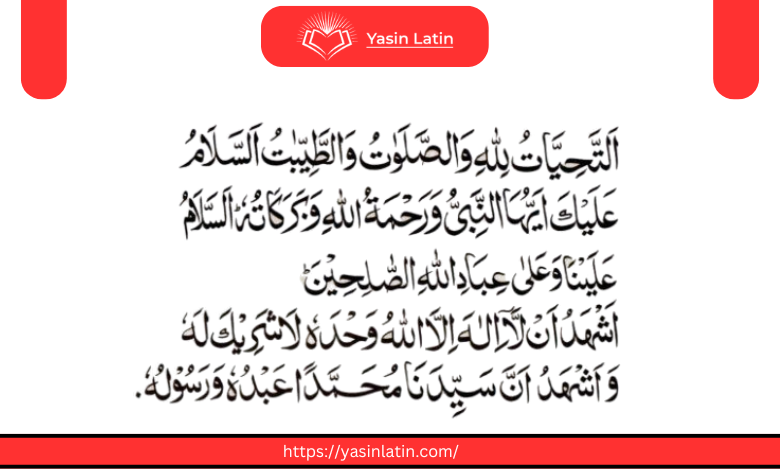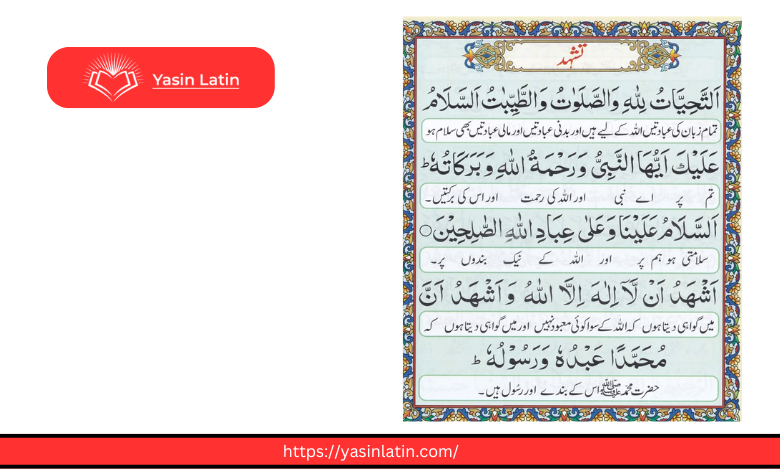The Tashahhud (تَشَهُّد) is one of the most essential components of Islamic prayer (Salah). It is a declaration of faith, a greeting, and a supplication that holds immense spiritual significance. Recited during the sitting posture of Salah, the Tashahhud serves as a moment of reflection, gratitude, and connection with Allah. This article provides a detailed exploration of the Tashahhud, its importance, how to recite it, and its role in Salah. Whether you are a beginner or seeking to deepen your understanding, this guide will help you master the Tashahhud and enhance your prayer experience.

Contents
- 1 Table of Contents
- 2 1. What Is the Tashahhud Prayer?
- 3 The Obligation of Tashahhud
- 4 The Authentic Formulations of Tashahhud
- 5 2. Importance of Learning the Tashahhud Prayer
- 6 Why Is Learning the Tashahhud Important?
- 7 3. What to Say in the Tashahhud Prayer
- 8 Arabic Text of Tashahhud
- 9 Transliteration
- 10 English Translation
- 11 Sending Blessings Upon the Prophet (Salawat)
- 12 4. Is the Tashahhud Prayer Obligatory?
- 13 Key Points About the Obligation of Tashahhud
- 14 5. Learn Sharia Online with Ulum Al-Azhar!
- 15 Why Choose Ulum Al-Azhar?
- 16 6. Conclusion to the Tashahhud Prayer
- 17 7. FAQs on the Tashahhud Prayer
- 18 1. What is the final prayer of the Tashahhud?
- 19 2. What is obligatory in the Tashahhud?
- 20 3. What if I forget the first Tashahhud?
- 21 4. Can I recite the Tashahhud in my own language?
- 22 5. How can I memorize the Tashahhud?
- 23 Surah Shams: Arabic Text, Latin Transliteration, and English Translation
Table of Contents
1. What Is the Tashahhud Prayer?
2. Importance of Learning the Tashahhud Prayer
3. What to Say in the Tashahhud Prayer
4. Is the Tashahhud Prayer Obligatory?
5. Learn Sharia Online with Ulum Al-Azhar!
6. Conclusion to the Tashahhud Prayer
7. FAQs on the Tashahhud Prayer
1. What Is the Tashahhud Prayer?
The Tashahhud, also known as At-Tahiyyat (التَّحِيَّاتُ), is a supplication recited during the sitting posture of Salah. It is an integral part of the prayer and is recited twice in prayers that consist of three or four rakats (units of prayer). The first Tashahhud is recited after the second rakat, and the final Tashahhud is recited in the last sitting posture before concluding the prayer with the Salam (greeting of peace).
The word Tashahhud comes from the Arabic root شَهَدَ (shahada), which means “to testify” or “to bear witness.” This reflects the core message of the Tashahhud, which includes the declaration of faith (Shahada) and sending blessings upon the Prophet Muhammad (peace be upon him).
The Obligation of Tashahhud
The Tashahhud is considered wajib (obligatory) by several Islamic schools of thought, including the Hanafi, Hanbali, and one narration from the Maliki school. Scholars such as Ibn Baz and Ibn Uthaymin also support this view. While omitting the Tashahhud does not invalidate the prayer, its inclusion ensures the completeness and perfection of Salah.
The Authentic Formulations of Tashahhud
The Tashahhud consists of specific phrases that acknowledge Allah’s sovereignty and send blessings upon the Prophet Muhammad (peace be upon him). These formulations have been narrated in authentic hadiths and are universally accepted by scholars.
2. Importance of Learning the Tashahhud Prayer
The Prophet Muhammad (peace be upon him) emphasized the importance of the Tashahhud during prayer. He instructed his companions:
“When the Imam recites, then listen attentively, and if he is sitting (in the prayer), then the first remembrance that anyone of you recites should be the Tashahhud.” (Sahih Muslim)
The Tashahhud is not just a ritual; it is a profound act of worship that connects the believer with Allah and the Prophet Muhammad (peace be upon him). By reciting the Tashahhud, Muslims acknowledge Allah’s greatness, testify to the oneness of Allah, and send blessings upon the Prophet. It is as though the reciter is sending greetings to every righteous servant of Allah, whether in the heavens or on earth.
Why Is Learning the Tashahhud Important?
· Spiritual Connection: The Tashahhud strengthens the believer’s connection with Allah and the Prophet Muhammad (peace be upon him).
· Completion of Salah: Reciting the Tashahhud ensures the completeness of the prayer.
· Declaration of Faith: It includes the Shahada, the fundamental declaration of Islamic faith.
· Blessings and Mercy: Sending blessings upon the Prophet (peace be upon him) brings immense rewards and mercy from Allah.
3. What to Say in the Tashahhud Prayer
The Tashahhud is recited in Arabic, and its text is derived from authentic hadiths. Below is the Arabic text, transliteration, and English translation of the Tashahhud:
Arabic Text of Tashahhud
التَّحِيَّاتُ لِلَّهِ وَالصَّلَوَاتُ وَالطَّيِّبَاتُ، السَّلاَمُ عَلَيْكَ أَيُّهَا النَّبِيُّ وَرَحْمَةُ اللَّهِ وَبَرَكَاتُهُ، السَّلاَمُ عَلَيْنَا وَعَلَى عِبَادِ اللَّهِ الصَّالِحِينَ، أَشْهَدُ أَنْ لاَ إِلَهَ إِلاَّ اللَّهُ، وَأَشْهَدُ أَنَّ مُحَمَّدًا عَبْدُهُ وَرَسُولُهُ
Transliteration
At-tahiyyatu lillahi was-salawatu wat-tayyibat, as-salamu ‘alaika ayyuhan-Nabiyyu wa rahmatAllahi wa baraktuhu. As-salamu ‘alaina wa ‘ala ‘ibad illahis-salihin, ashahdu an la illaha ill-Allah wa ashhadu anna Muhammadan ‘abduhu wa rasuluhu.
English Translation
All compliments, prayers, and pure words are due to Allah. Peace be upon you, O Prophet, and the mercy of Allah and His blessings. Peace be upon us and upon the righteous servants of Allah. I testify that there is no god but Allah, and I testify that Muhammad is His servant and Messenger.
Sending Blessings Upon the Prophet (Salawat)
After reciting the Tashahhud, it is recommended to send blessings upon the Prophet Muhammad (peace be upon him) by reciting:
اللَّهُمَّ صَلِّ عَلَى مُحَمَّدٍ وَعَلَى آلِ مُحَمَّدٍ كَمَا صَلَّيْتَ عَلَى إِبْرَاهِيمَ وَعَلَى آلِ إِبْرَاهِيمَ، إِنَّكَ حَمِيدٌ مَجِيدٌ، اللَّهُمَّ بَارِكْ عَلَى مُحَمَّدٍ وَعَلَى آلِ مُحَمَّدٍ كَمَا بَارَكْتَ عَلَى إِبْرَاهِيمَ وَعَلَى آلِ إِبْرَاهِيمَ، إِنَّكَ حَمِيدٌ مَجِيدٌ
Transliteration:
Allahumma salli ‘ala Muhammadin wa ‘ala ali Muhammadin, kama sallayta ‘ala Ibrahima wa ‘ala ali Ibrahima, innaka Hamidun Majid. Allahumma barik ‘ala Muhammadin wa ‘ala ali Muhammadin, kama barakta ‘ala Ibrahima wa ‘ala ali Ibrahima, innaka Hamidun Majid.
Translation:
O Allah, send Your blessings upon Muhammad and the family of Muhammad, as You sent blessings upon Ibrahim and the family of Ibrahim. Indeed, You are Praiseworthy and Glorious. O Allah, bless Muhammad and the family of Muhammad, as You blessed Ibrahim and the family of Ibrahim. Indeed, You are Praiseworthy and Glorious.
4. Is the Tashahhud Prayer Obligatory?
The Tashahhud is considered wajib (obligatory) by many scholars, meaning it is highly recommended and should not be omitted without a valid reason. However, if someone forgets to recite the Tashahhud, their prayer is still valid, but they should perform the prostration of forgetfulness (Sujood al-Sahw) to compensate for the omission.
Key Points About the Obligation of Tashahhud
· The first Tashahhud (after two rakats) is Sunnah (recommended) but not obligatory.
· The final Tashahhud (before concluding the prayer) is wajib (obligatory).
· Reciting the first half of the Tashahhud is obligatory, while the second half (sending blessings upon the Prophet) is recommended.
· Ending the prayer with Salam is obligatory.
5. Learn Sharia Online with Ulum Al-Azhar!
If you are eager to deepen your understanding of Islamic prayers, including the Tashahhud, consider enrolling in online courses offered by Ulum Al-Azhar. This esteemed academy provides authentic Islamic education under the guidance of certified scholars from Al-Azhar University in Egypt.
Why Choose Ulum Al-Azhar?
· Authentic Syllabuses: Developed by Al-Azhar scholars.
· Certified Instructors: Fluent in English and experienced in teaching Islamic studies.
· One-on-One Classes: Personalized attention to ensure 100% comprehension.
· Affordable Prices: Flexible payment options and discounts available.
By joining Ulum Al-Azhar, you can embark on a journey of spiritual growth and enlightenment, mastering the art of Salah and other essential aspects of Islamic knowledge.

6. Conclusion to the Tashahhud Prayer
The Tashahhud is a profound and essential part of Salah that connects the believer with Allah and the Prophet Muhammad (peace be upon him). It serves as a declaration of faith, a moment of reflection, and a means of seeking blessings and mercy. By learning and reciting the Tashahhud with understanding and sincerity, Muslims can enhance their prayer experience and draw closer to Allah.
As you continue to explore the beauty of Islamic prayers, consider enrolling in courses at Ulum Al-Azhar to further deepen your knowledge and practice. Embrace this journey of learning and spiritual growth with us.
7. FAQs on the Tashahhud Prayer
1. What is the final prayer of the Tashahhud?
In the final Tashahhud, Muslims recite:
“As-salamu ‘alayna wa ‘ala ‘ibad illahis-salihin” (Peace be upon us and upon the righteous servants of Allah).
2. What is obligatory in the Tashahhud?
· Sitting for the final Tashahhud is obligatory.
· Reciting the first half of the Tashahhud is obligatory, while the second half (sending blessings upon the Prophet) is recommended.
· Ending the prayer with Salam is obligatory.
3. What if I forget the first Tashahhud?
If you forget the first Tashahhud, your prayer remains valid. However, you should perform the prostration of forgetfulness (Sujood al-Sahw) before concluding the prayer with Salam.
4. Can I recite the Tashahhud in my own language?
While it is recommended to recite the Tashahhud in Arabic, beginners may use transliterations to learn. However, the ultimate goal should be to memorize and recite it in Arabic.
5. How can I memorize the Tashahhud?
· Write it down and read it repeatedly.
· Practice reciting it during Salah.
· Use audio recordings to improve pronunciation.
· Seek guidance from a qualified teacher or online course.
By mastering the Tashahhud, you can ensure the completeness of your Salah and experience the spiritual benefits of this beautiful supplication.
Read More >>

